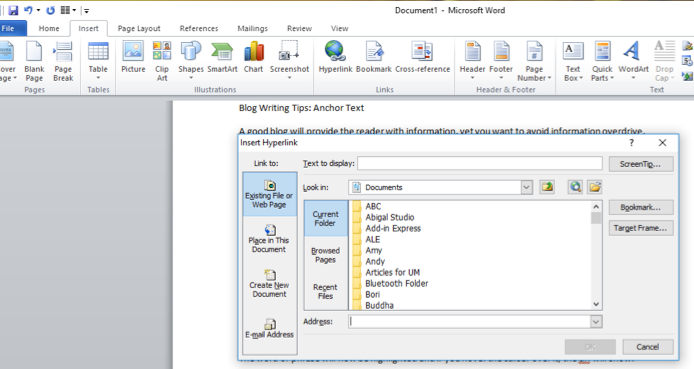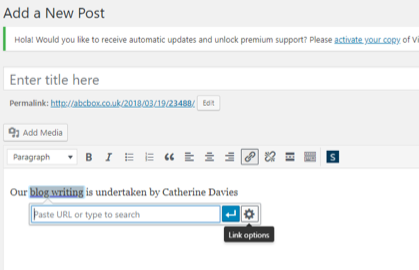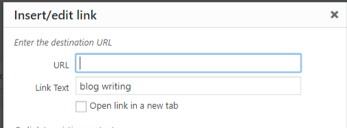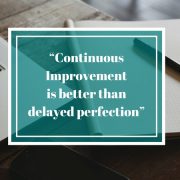Anchor Text
Blog Writing Tips: Anchor Text
A good blog will provide the reader with information, yet you want to avoid information overdrive. This is where links come in.
Creating a Link
Any blog or article should include a link. The link should direct the reader to further information that expands on the topic of the blog. It could be a webpage, another blog or a published paper on your website (internal link) or on another website (external link).
You create a link, by:
- Highlighting a word or phrase in your blog (the Anchor Text)
- Clicking on the ‘Insert’ tab
- Selecting Hyperlink
- Adding the website URL that you wish to direct readers to

The anchor text will now be highlighted and if you hover the curser over it, the URL will show.
The Anchor Text
For SEO purposes t’s important that the search engines can see a direct link between the anchor text and the page that it directs to. Ideally, there should be an exact match between the text and URL.
Avoid Common Mistakes
Weak anchor text
If you want your website to be well ranked, you need to keep the search engines and your website visitors happy. This includes making every detail count, including good use of anchor text in blog writing. The example below shows that a small change can make a big difference when it comes to relevant anchor text.
“For further information on our catering packages click here” – ‘here’ lacks the exact match that the search engines are looking for and it isn’t sufficiently specific for the reader either. It’s a missed opportunity to show the relevance of the link. An alternative could be:
“We are happy to provide further information on corporate catering and sample menus.” – In this second option, there is the potential to link with two relevant pages of a website, using an exact text match. It’s a small change that will improve the effectiveness of your website.
Directing to the Home page
The match works both ways. In the example above, anyone clicking on Sample Menus will expect to see exactly that – a page of sample menus. If they are taken to the Home Page and then have to navigate to the Sample Menus page it’s frustrating.
It may only take seconds to navigate to the right page, but why should they? It is enough to put some people off and it doesn’t score any points with the search engines either.
Open Links in a New Tab
There are arguments in favour and against setting up links to open in a separate tab. When it comes to internal links, a separate tab isn’t necessary, but it’s a good idea for external links. This is because you don’t want to send your visitors to another site and not provide them with an easy way back.
If you have a WordPress site, as you highlight the anchor text and click on the hyperlink icon, you’ll see a cog icon; click on this for Link Options.

A box will open up for you to add the URL and there is a tick box option to ‘Open link in a new tab’.

In Summary
It’s a good idea to make us of links in your blog writing. Keep your readers happy by directing them to the page where the conversation naturally continues and ensure that you match the page URL with the anchor text. When it comes to external links, opt for opening in a new tab. If you prefer to outsource your blog writing, get in touch.









